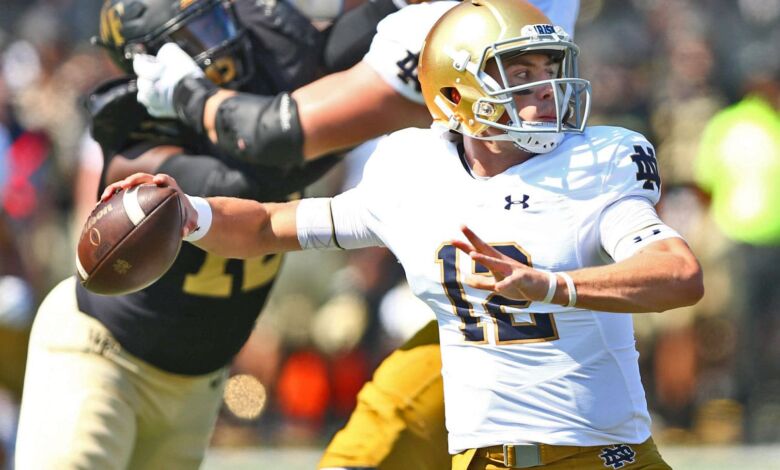
Every week, usually on a Tuesday, a great service is done by Bill Connelly of SBNation for college football fans. He is the developer of the S&P+ formula I have talked about so many times, and he goes the extra mile of compiling an advanced statistical profile of most FBS teams for people to pour over. The information can be invaluable for anyone who wants a good idea of what their team is good at, and what it is not. Fans can get bogged down in narratives and pre-conceived notions about a team or a player, but the data is what it is. If you’re interested in giving it a look yourself, you can find Bill’s information here.
A couple of things right off the bat:
- Notre Dame is currently ranked 11th in S&P+. They started the season at #9, rose to #8 following the win against Michigan (who is currently ranked 5 by the way) and fell to 17 following Ball State, and 18 after Vanderbilt. They rose to 11 after the drubbing of Wake Forest. The data seems to confirm what we all saw, the team was going the wrong way after Michigan.
- The Notre Dame defense is ranked 6th in total S&P, while the offense is 46th. The offense was in the upper 60’s pre-Wake Forest. Again, a change had to be made on offense, a top ten defense was going to get wasted behind an under-achieving offensive unit.
- Further driving the point home of a good team being wasted, Notre Dame has a second-order wins total of 2.9, and a win expectancy percentage under 50% in two games, Michigan and Vanderbilt. This means that the statistical profile of both of those games lends itself to a Notre Dame loss, meaning the Irish have 1.1 more wins than their stats would suggest.
- For the rest of the season, Notre Dame doesn’t have a win expectancy percentage below 66% (at USC), and is favored this weekend by 7.
The Defense Is Limiting Big Plays
The Irish defense is 12th and 15th nationally in the two explosiveness metrics tracked by Connelly, 11th in rushing explosiveness and 26th in passing explosiveness. This has been a key to the formula on defense. They’ve given up drives and yards, but very little has come easy for the offense, especially on the ground. The defense is good enough to where forcing the offense to drive the length of the field eventually leads to a stalled drive and a field goal attempt. This is not at all unlike the famed 2012 unit, by the way.
Relatedly, the defenses 11 to 20 yard line success rate is 37th, and their inside the 10 success rate is 23rd.
Sacking The Quarterback Is The Last Step
Notre Dame has a sack rate that ranks 87th in the nation, but is on pace for 78 quarterback hurries. Have to figure those two numbers will switch and the hurries they are accumulating will pay off with more robust sack figures. College Football Film Room tracks quarterback pressures and they have four Notre Dame defenders with double digit pressures. The Irish are a top 10 defense as it is, if they start bringing down the quarterback and killing drives that way, ooh boy.
Through just four games, Notre Dame already has four pass-rushers with double-digit QB pressures pic.twitter.com/gc83CJIv3e
— CFB Film Room (@CFBFilmRoom) September 26, 2018
Playing Wimbush Didn’t Help Notre Dame’s Explosiveness
The Irish offense ranks 78th and 84th in the explosiveness metrics, numbers that weren’t that high prior to Book starting against Wake. The conventional wisdom is Wimbush was a boom or bust player, and the booms were too few and far between to justify keeping him out there. And as we saw against Wake, there are plenty of opportunities out there for Notre Dame’s offensive players if they are given opportunities to handle the ball in space.
Notre Dame’s Third And Short Success Rate Is Perfect
The most common complaint I see about Notre Dame is they are soft which is why they are bad on third and short. They can’t run it and therefore have to pass which leads to stalled drives. Well, the data says that’s silly. Notre Dame is ranked one, with a 100% success rate on third and short. Coincidentally, Book has been in for a lot of those situations with Notre Dame’s I-formation package, although to be fair Wimbush was involved there as well. For whatever the logic was in playing Book in those spots, it has worked out for the Irish, as perfect is usually a fair sign of success.
Notre Dame Needs More From Chase Claypool
Claypool leads the team in targets with 22, has the worst completion percentage among the top four pass catchers at 50%, and is the only pass catcher in the top five with an efficiency score in the negative percentages (-4.0%). For an offensive player you want those numbers to be in the positive, the higher the better. The next lowest efficiency percentage amongst the top pass catchers is Miles Boykin at 8.9%. In many ways, Claypool is Notre Dame’s most talented receiver, but at the moment he isn’ t performing at a very high level. He’s only played one game with Book, and maybe that will have a positive effect on him, but so far the results haven’t been the best.
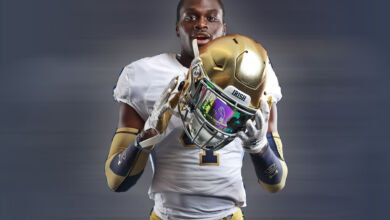
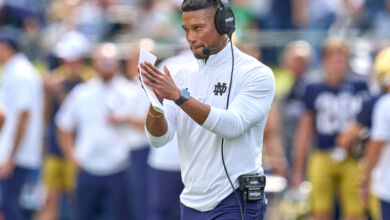
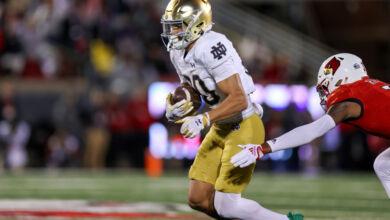
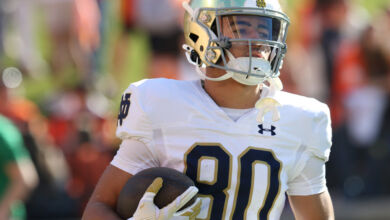
Stats are important. Trends are much more important.
BGC ’77 ’82
Another brief note – there has been plenty of coach trashing on this site, e.g., Kelly does nothing on player development. Is it possible that they have been trying all along with Brandon Wimbush and he just wasn’t getting it? Maybe he just doesn’t have it as a QB? Maybe all that potential is leading in a different direction? He is obviously a gifted athlete. Can they find another role for him?
Go Irish!!!!!
SO TRUE BRAD!! Being a QB all your life like WIMBUSH and still struggling with the same problems over and over, like going thru progressions and throwing a bullet pass instead of a lob ball are just bad tendencies that he should have grown out of by HIGH SCHOOL!! NO EXCUSES!!
Is there information on Stanford too? And will you post that too?
I’m just spit balling here but I’m guessing that information is on the Stanford website.
already checked – and couldn’t locate info on SBnation – Not sure where it is exactly. So, I’m hoping he’ll be a mensch
and post Stanford’s info here too.